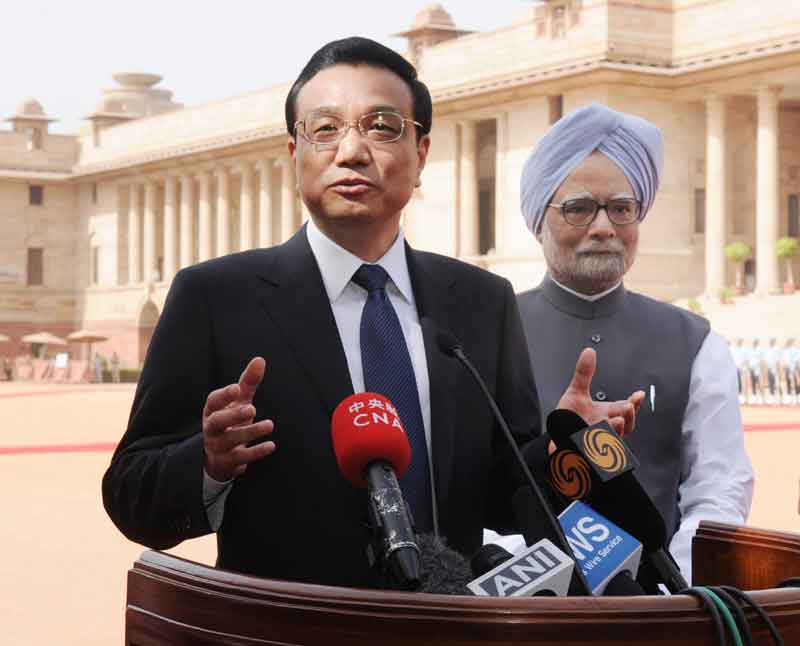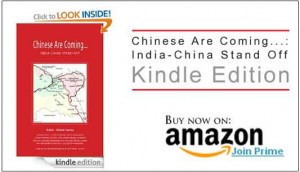
Premier of the State Council of the People’s Republic of China Li Keqiang and the Prime Minister Manmohan Singh
India will have to manage its relationships with China and Japan with greater finesse. China constitutes by far our most difficult diplomatic challenge as its rise impacts us directly in view of its territorial claims on us, the unsettled Tibetan situation, the potential impact of China’s upstream river projects, its “more precious than gold” relationship with “iron brother” Pakistan, its strategic penetration in other neighbouring countries as well as in the Indian Ocean. The imbalance in our bilateral trade ties is also becoming unsustainable.
We justified our nuclear tests in 1998 because of the China threat. Subsequently, we gave China satisfaction by declaring that we did not view it either as a threat or an adversary.
Chinese power is challenging us in Central Asia, the Gulf and Africa, aided by its much larger financial reservoir which it uses for gaining access to energy and mineral resources for its future growth under State direction that India cannot equal. The India-China equation is getting progressively tilted in China’s favour globally. Politically, this draws countries of interest to us into the Chinese orbit; economically, it affects the direction of international trade and investment flows in Asia to our disadvantage.
Yet, we reach out to China as if it is a partner-in-waiting and project congruence of interests bilaterally and multilaterally even where they are in conflict. There is a palpable disconnect between how we see China in private and how we treat it in public.
We justified our nuclear tests in 1998 because of the China threat. Subsequently, we gave China satisfaction by declaring that we did not view it either as a threat or an adversary. We have established a strategic partnership with China even when it has long countered us strategically. We say glibly that China is not a competitor and that the world is big enough to accommodate the rise of both countries. On the heels of the Ladakh incident we have affirmed that our relationship is a model of co-existence between big neighbouring countries. We say we support our respective friendships with common neighbours, contrary to reality. We are open to maritime cooperation with China in the Indian Ocean when its increasing presence there causes us concern. Even on the nuclear issue, where China has been the source of our biggest strategic challenge, we talk about civilian nuclear cooperation with it. We are consciously letting China off the hook on every issue of concern to us and attributing a benign air to its policies.
Perhaps we judge that any perception of mounting India-China differences reduces our capacity to bargain with other power centres. We probably want to give less room to those who would prefer China and India to be pitted against each other as such a conflict in Asia’s heart would suit their interests. We might be reasoning that those seeking to incorporate us into their anti- China strategy cannot themselves ignore the reality of China, and that with the already achieved integration of its huge economy with the global one any scope for confrontation is limited. Moreover, our role in the Association of Southeast Asian Nations and the East Asia Summit, our participation in the emerging Asian security architecture, our BRICS dialogue and collaboration with China on the World Trade Organization and climate change issues, would be strained by India-China wrangles.
We are consciously letting China off the hook on every issue of concern to us and attributing a benign air to its policies.
Such thinking has merit up to a point, but between exaggerating levels of understanding with China to ward off external exploitation of our underlying differences and constantly ceding ground politically to it bilaterally on contentious issues and helping it to present an accommodative face to an anxious international community by being receptive to its tactical grandstanding in India during Li Keqiang’s visit, we have room to craft a more balanced policy.
Just when wariness of China is growing we make a show of bonhomie with it. When Myanmar wants to dilute its dependence on China and the United States of America and Japan court it, we advocate an economic corridor between China, Myanmar, Bangladesh and India that would promote Chinese influence in this region. We are ready to allow our Northeast to move economically into China’s orbit, as if that would help us to better integrate it with the rest of India and Arunachal Pradesh can be insulated from Chinese inroads there. If China was visibly moderating its policies in our periphery and on our territorial differences, our postures would make better sense. But then, The Global Times has just reminded us that “India must accept and adapt to the enviable friendship between China and Pakistan. China cannot scale down this partnership merely because of India’s feelings!”
Under its prime minister, Shinzo Abe, Japan is reaching out to India as never before with the shared threat from a muscle-flexing China in mind. China has tried to queer this pitch with the prime minister, Li Keqiang, landing in India before our prime minister travelled to Japan in late May and wooing us with rhetoric and smiles, an exercise in which we willingly participated. This contrived show of friendship and harmony lacked diplomatic finesse, as signalling to the Japanese that our relations with them and China followed matching tracks weakens our playing hand with both. Buoyed by the success of Li Keqiang’s visit, Chinese commentators have lectured Japanese politicians — described as “petty burglars” — on the manner in which India and China managed to “properly” solve their border stand-off quickly. Such contemptuous rhetoric towards Japan should caution us not to take China’s engaging tone towards us too seriously.
If China wants full freedom to calibrate the level of its relations with our neighbours, it cannot question India’s freedom to boost its ties with Japan. It is significant that the Sri Lankan president’s visit to China (May 27-30) overlapped with that of Manmohan Singh’s to Japan (May 27-29), with the Chinese prime minister announcing during the visit that China-Sri Lanka ties had reached the stage of “strategic cooperation”. Given its own policies to balance us strategically in our own region, China cannot object to the stated intention of India and Japan to strengthen their strategic partnership, including defence ties, with more frequent bilateral naval exercises.
Nothing in our prime minister’s visit to Japan was prejudicial to China’s legitimate interests. The formulation in the joint statement on South and East China Seas — a subject of acute sensitivity for China — was a standard one supporting freedom of navigation and unimpeded commerce in accordance with international law. The reaffirmation of the importance of the East Asia Summit forum for building an open, inclusive and transparent architecture of regional cooperation in the Asia-Pacific was standard fare too.
The prime minister’s reference to India and Japan as natural and indispensable partners for mutual prosperity and a peaceful and stable future for the Asia Pacific and Indian Ocean regions was unexceptionable. The Global Times nevertheless warned in an article titled, “India gets close to Japan at its own peril” that “overheated strategic cooperation with the Abe administration can only bring trouble to India and threaten its relationships with the relevant East Asian countries”— implying China too. Such finger-wagging predictably ignored the India-China joint statement that unrealistically mentioned that “the two sides are committed to taking a positive view of and support each other’s friendship with other countries”. Such bullying attitudes encouraged by our appeasement of China need to be decried as we forge a durable strategic and global relationship with Japan and others, to circumscribe China’s challenge.






Mr. Sibal’s comments are on the mark. It should be amply clear that the noises being made by China are well managed and thought out by the Chinese central authority. They are laying the ground work for China to control its interests in Asia in context of the other powers, namely, India and Japan. What should also be clear is that the current Indian administration has failed repeatedly to assert India’s posture in this unfolding geopolitical face-off. India has no other option but to mobilize its resources and relationships with other friendly nations for maintaining a sense of balance in military and security. Any short term tactical planning should include alliances with Japan, NATO and US. Long term planning should include defense technology advancements to match and exceed China based on joint ventures with the preferred partners. India has the brain, brawn and brand appeal in the free world to turn things around before China gains an upper hand. If the only purpose of the Indian defense organization is to plan a counter attack after Chinese forces have moved into Indian territories, India has lost the war same as it did when the invading hordes from the North rode on horsebacks into India and ruled the country for five hundred years.